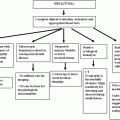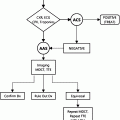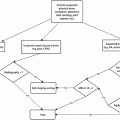Imaging modality
Reimbursement ($)a
CR
35
Skeletal survey
75
US limited (mass)
45
US complete (tendons, muscles, etc.)
130
CT (w/o, w/)
245–300
BS
275
BS (3 phase)
315
Labeled WBC study
375
MRI (w/o, w/ and w/o)
430–675
PET/CT
1,225
It is important for clinicians to understand how contrast agents apply to imaging. Basic familiarity with common indications, significant contraindications and potential complications of contrast media use are essential for optimal patient care. We discuss the indications, contraindications, and risks of contrast agents that are routinely used in clinical practice today. This knowledge may be reinforced, and at times supplemented by radiologists in their role as consultants who are part of the medical team charged with quality diagnostic imaging management.
Imaging Modalities
Overview
The most commonly used imaging technologies include conventional radiography (CR), computed tomography (CT), ultrasound (US), magnetic resonance imaging (MRI), and a variety of nuclear medicine studies (NM), each with a specific purpose (Table 1.2). While CR is typically a starting point for most evaluations in the chest, abdomen, and MSK system, this is not always the case. For example, soft tissue pathology generally is better evaluated by more advanced techniques, particularly MRI, US, and at times CT.
Table 1.2
Common diagnostic imaging modalities
Imaging modality | Advantages | Disadvantages and limitations |
|---|---|---|
Conventional radiography (CR) | Very inexpensive | Ionizing radiation |
Universally available | Low contrast resolution | |
Quickly obtained | Limited evaluation of soft tissues | |
Projectional superimposition (2-D representation of 3-D anatomy and pathology) | ||
Ultrasound (US) | Relative low cost (vs. CT, MRI, NM) | Operator-dependent |
No ionizing radiation | Limited availability of well-trained, experienced MSK sonographers | |
Real time imaging | Narrow field of view | |
Provocative patient maneuvers | Targeted, focused exam lacking the anatomic overview of other modalities | |
Guidance for numerous procedures | ||
Computed tomography (CT) | Very wide availability | Ionizing radiation |
Rapid image acquisition | Potential adverse reactions if IV contrast needed | |
Largely “turnkey” and operator-independent | Insensitive for bone marrow abnormalities | |
Guidance for numerous procedures | ||
Excellent assessment of cortical bone (including erosion and destruction by tumor, infection, or inflammatory arthritis) | ||
Magnetic resonance imaging (MRI) | No ionizing radiation | Expensive |
Outstanding soft tissue contrast resolution | Comparative less availability | |
Superb bone marrow evaluation | Numerous contraindications | |
Long imaging time, claustrophobia | ||
Nephrogenic systemic fibrosis (NSF) risk from gadolinium-based contrast agents (GBCAs) | ||
Relatively limited assessment of cortical bone (vs. CT) | ||
Nuclear medicine (NM) | Less expensive than MRI | Ionizing radiation |
Bone scintigraphy (BS) | Very large field of view (whole body assessment routinely performed) | Specificity limited (recently improved by adding CT) |
Labeled leukocyte study (WBC) | Allows evaluation for multifocal disease | Relatively limited in precise anatomic localization of pathology (better with SPECT, recent improvement with CT) |
Low resolution | ||
Sensitivity high | Long study length (especially labeled WBC: imaging performed 2–4, 24, and possibly also 48 h postinjection) | |
Negative predictive value (NPV) high | ||
Nuclear medicine (NM) | Very large field of view (whole body assessment routinely performed) | Ionizing radiation |
FDG-PET | ||
Allows evaluation for multifocal disease | Limited availability | |
Sensitivity high | High cost | |
Negative predictive value (NPV) high | Insurance reimbursement roadblocks | |
Comparatively limited in precise anatomic localization of pathology | ||
(recently improved by addition of CT to create hybrid PET (PET/CT)) |
Conventional Radiography
Radiographs serve as the starting point in the imaging diagnosis of many categories of suspected pathology, e.g., pneumonia and congestive heart failure in the chest, small bowel obstruction and suspected free intraperitoneal air in the abdomen and especially for trauma, osteomyelitis, focal mass lesions, and arthropathies in the MSK system. Plain radiographs are inexpensive, widely available, and rapidly obtainable, even at the bedside if necessary. Disadvantages of radiographs include ionizing radiation and low contrast resolution making them unable to visualize most soft tissue abnormalities.
Ultrasound
US is less expensive than CT, MRI, and NM. In addition, it does not expose the patient to ionizing radiation, an important consideration particularly in children and pregnant women. In appropriate well-trained, experienced hands, sonography excels in a number of applications. One of its main strengths is the ability to distinguish cystic from solid lesions. In addition, application of Doppler US enables visualization of a lesion’s vascularity. US permits real time imaging, which allows for provocative maneuvers to detect pathology that is not well shown on static imaging studies. Examples of provocative maneuvers using dynamic real time US include compression of the gallbladder (sonographic Murphy sign) in evaluation of cholecystitis, elbow flexion to elicit ulnar nerve subluxation from the cubital tunnel, hip flexion to show snapping of the iliopsoas tendon in the groin, or compression of vessels to augment flow and show the absence of thrombus. US can also be used to guide interventional procedures including biopsy, e.g., liver or mass biopsy, and therapy such as injection of tendon sheaths, joints, bursae, and peritendinous soft tissues, e.g., the common extensor tendon origin at the lateral epicondyle of the elbow (tennis elbow).
US is operator-dependent. This means that specifically trained imagers are needed for this type of examination. US transducers have a narrow field of view, and so with today’s scanning methods, it is possible to overlook pathology. Accordingly, US tends to be most successful when used to answer a specific clinical question with a focused examination of a limited anatomic region. Despite these limitations, the role of US continues to expand, especially the use of ultrasound-guided procedures.
Computed Tomography
CT technology has improved vastly since its introduction. It is now possible to image any part of the body with high spatial and moderate contrast resolution. Similar to CR, CT is readily and near universally available, even in rural locations, “after hours” and on weekends when other modalities are not available. As a result, CT has become the workhorse of diagnostic imaging. With newer scanners, it is possible to image large tissue volumes rapidly and if necessary repeatedly. This means that CT scans, either without or with the use of oral and/or intravenous contrast, can be configured to answer many clinical questions in every organ system. In fact, CT angiography has largely replaced conventional angiography for routine diagnosis.
When MRI is contraindicated or unavailable, CT often serves as a backup examination. In these cases, it is important to understand the differences in sensitivity and specificity between the two modalities for the clinical question being addressed. CT has better spatial resolution than MRI and is more sensitive at identifying calcium, but it has much lower contrast resolution compared with MRI, making its differentiation of structures poor in some parts of the body. These differences determine the value of attempting a CT as an alternative to MRI. This information will be covered further in the chapters on imaging of specific organ systems.
The main disadvantage of CT is its use of ionizing radiation. CT gives a higher dose of radiation to the patient than routine CR. Several studies have suggested that liberal use of CT will increase the incidence of neoplasms years on. In fact, today, dose levels with each scan are reported and recorded. So, while CT is an excellent diagnostic tool, the danger of high accumulated doses of radiation with this modality should temper its use. This is particularly true in the pediatric population where US should be employed whenever possible to avoid the radiation exposure from CT.
Magnetic Resonance Imaging
Although comparatively expensive, MRI is a commonly performed examination, particularly in neurologic, MSK, and to some extent cardiothoracic and abdominal disease. MRI has superior contrast resolution to other modalities and so is able to depict soft tissue structures that cannot be resolved by other imaging techniques.
As with CT, contrast agents are available for MR. These agents, primarily gadolinium-based, behave similarly to the iodinated contrast agents used for CT and fluoroscopic imaging. They have specific indications that will be discussed in each organ system chapter as appropriate. Other contrast agents are becoming available for specific use, for example, iron-based agents for the liver that are designed specifically for uptake by Kupffer cells. These are not yet widely available and have issues with toxicity.
MRI can accommodate a larger field of view than US, but it is important to understand that as the field of view increases, spatial resolution suffers. Spatial resolution is limited with MRI, and so the larger the field of view, the coarser the image detail obtained. In general, if a large area of the body needs to be imaged, or if there is suspicion for multifocal disease that requires imaging more than one anatomic location, nuclear imaging should be strongly considered in place of MRI. These scans, though often nonspecific, can include nearly the entire body in their field of view, something that is impractical with MRI. On the other hand, in some circumstances wide field of view MRI is useful, for example when surveying the skeleton for multiple myeloma.
There are a number of relative and absolute contraindications to the use of MRI. Because MRI uses strong magnetic fields, it can be dangerous to put patients with ferromagnetic devices and implants into a scanner (Table 1.3). First, depending on the device, its location in the body, and the duration that it’s been implanted, the magnetic field may cause it to torque or dislodge. Second, depending on the configuration of the implanted device, the MR unit may cause it to generate microwaves and local tissue heating. Finally, the MR unit’s magnetic field can trigger some pacemakers to go into test mode.
Table 1.3
Study contrast media utilizationa and contraindications in MRI/CT
Imaging modality | Indications (dosing route) | Contraindications (CI): absolute (A), relative (R) |
|---|---|---|
MRI | Paraspinal, epidural abscess (IV) | Endocranial vascular clips (some) (A) |
Soft tissue abscess (IV) | Intra-aortic balloon pump (A) | |
Intraosseous abscess (IV) | LVAD, RVAD (A) | |
Bone sequestrum (IV) | Pulmonary artery catheter (A) | |
Suspected early RA (IV) | Cardiac pacemaker (R) | |
Synovitis, tenosynovitis (IV) | Implantable cardiovertor-defibrillator (R) | |
Myositis (IV) | Capsule endoscopy device-Pillcam (A) | |
Soft tissue mass (IV) | Hemostatic vascular clips (some) (A) Cochlear implants (R) | |
Soft tissue necrosis, myonecrosis (IV) | Eye metallic foreign body (R) | |
Osteonecrosis (IV) | Insulin pump (R) | |
Direct MR arthrography (IArt) | GFR <15 mL/min (R) | |
Indirect MR arthrography (IV) | ESRD on chronic dialysis (R) | |
Vascular enhancement (IV) | GBCA use during pregnancy (R) | |
CT | Paraspinal, epidural abscess (IV) | Previous severe adverse reaction (e.g., profound vasovagal reaction, seizure, moderate and severe bronchospasm, laryngeal edema, severe hypotension, sudden cardiac arrest, cardiopulmonary complete collapse, and organ and system-specific adverse events) |
Soft tissue abscess (IV) | Acute kidney injury (AKI) | |
Soft tissue mass (IV) | Oliguric dialysis patient (e.g., not ESRD anuric dialysis patient) | |
Soft tissue necrosis, myonecrosis (IV) | ||
CT arthrography (IAart) | ||
Vascular enhancement (IV and IA) |
The list of contraindicated materials is a fluid one and a constant work in progress, with new additions (and removals) being made on a frequent basis. Many newer devices and implants are specifically designed to be MR compatible. Manufacturers usually provide patients with MR compatibility documentation to carry with them. Resources on the web, e.g., www.mrisafety.com maintain online up-to-date databases on the MR safety of medical devices. In order to use these, however, the patient must be able to provide relevant information regarding their device such as the manufacturer, model number, and date of manufacture. Finally, many radiologists experienced with MRI can help determine which types of devices are MR compatible.
Nuclear Medicine
NM studies had been designed to evaluate specific problems in every organ system whether the endocrine, e.g., thyroid scans, the MSK system, bone scans for osseous metastases or in the GI system, GI bleeding studies, and HIDA scans for gallbladder disease. Most nuclear medicine scans, though nonspecific, have the advantage of being comparatively sensitive and of providing physiologic information regarding target pathology. Furthermore, the recent addition of positron emission scanning (PET) alone and in combination with CT (PET/CT) has moved nuclear medicine into the fore of soft tissue tumor diagnosis and staging. This technique allows subtle areas of tumor to be discovered, diagnosed, staged, and so appropriately treated. PET/CT also has provided new tools for assessment of tissue viability, particularly in cardiac applications.
Contrast Media
Overview
Over the years, various types of contrast media have been used in attempts to improve the quality of imaging. These have provided significant additive value to the imaging modalities where they have been utilized. As a result, today contrast media are used on a routine, daily basis, especially iodinated contrast media for CT and radiography and gadolinium-based contrast agents (GBCAs) with MRI.
The majority of indications for use of intravenous (IV) contrast agents, regardless of whether it is iodinated contrast media or a GBCA, involve use of cross-sectional imaging for infectious, inflammatory, ischemic, and neoplastic pathology. For example, IV contrast material aids in the detection and delineation of fluid collections, regardless of their anatomic location. It also facilitates assessment of osseous and soft tissue viability, e.g., showing areas of necrosis in soft tissue and bone neoplasms and bony sequestra in chronic osteomyelitis. Inflammatory processes such as a variety of types of myositis, tenosynovitis, and synovitis are also typically better evaluated with IV contrast media. In addition, both iodinated and gadolinium (Gd)-based contrast agents very frequently enable determination of whether a soft tissue mass is cystic or solid in nature. The indications for utilization of IV contrast media are given in Table 1.3.
Contrast is also used intra-arterially (IA) for direct evaluation of the vessels. This is usually done with a catheter placed selectively into the vessel to be imaged. For unknown reasons, allergic contrast reactions to IA injected media are much less common than for IV injected contrast. Even so, because of the greater morbidity of direct contrast arteriography and the sophistication of current CT technology, IV contrast and CTA are more commonly used today.
Contrast media is commonly used intra-articularly as well, allowing the radiologist to actively distend the joint and thereby improve separation of intracapsular structures and enhance image resolution (Table 1.3). Intra-articular contrast injection is much more commonly performed with GBCA and MRI than iodinated contrast and CT, because of the inherent superiority of MRI in soft tissue contrast resolution. Regardless, as with IA injections, allergic reactions with intra-articular contrast are rare.
Contrast is also used intrathecally for myelography. Since the advent of MRI, the indications for myelogram have fallen markedly, but they are still performed in patients where there is a contraindication to MRI or there is adjacent metallic hardware that will induce obscuring MRI artifact.
Contrast agents are not without risk. Adverse side effects from the utilization of contrast media vary from relatively common, minor physiological disturbances that are almost always self-limited to rare, severe life-threatening anaphylactic reactions. In addition, iodinated contrast agents are nephrotoxic and are contraindicated in patients with renal failure as they may worsen renal function precipitously. GBCA are associated with nephrogenic systemic fibrosis (NSF) in patient with poor renal function. Therefore, prior to giving a patient contrast, their renal status should be assessed. Risks of a reaction should be considered when making decisions regarding patient management [1].
Preceding the actual imaging of a patient, the radiologist in conjunction with the ordering physician should address a few preliminary considerations for any given patient. Specifically, the radiologist in particular should make best efforts to determine if there is an appropriate indication for the requested study, identify relative contraindications and pertinent risk factors that may increase the likelihood of an adverse reaction to contrast administration, and possess sufficient knowledge of alternative imaging modalities [1].
Risk Factors Associated with Iodinated Contrast Media
Risk factors for adverse reactions to IV iodinated contrast material include prior reaction, known allergy (history of prior allergic-type reaction particularly if moderate to severe in degree), asthma, renal insufficiency, and cardiovascular disease (if the patient has congestive heart failure symptoms or angina, severe aortic stenosis, severe cardiomyopathy, or primary pulmonary hypertension) [1]. There are a number of miscellaneous risk factors. One of these is multiple myeloma, which is known to cause irreversible renal failure from renal tubular protein precipitation and aggregation when high-osmolality contrast media (HOCM) is used in these patients. Other potential miscellaneous risk factors include β-adrenergic blockers, which are associated with more frequent and more severe adverse events, and pheochromocytoma, where an increase in serum catecholamine levels may be seen after IV injection of HOCM resulting in a hypertensive crisis [1].
Premedication
Patients who are known to be at higher risk for an acute allergic-type contrast reaction and for whom a scan is needed should be considered for premedication prior to a scan. Many adverse reactions are associated with direct release of histamine and other mediators from circulating basophils and eosinophils [1]. Studies have shown that IV steroids suppress whole blood histamine and show a reduction in circulating basophils and eosinophils [2].
This observation provides a scientific basis for the use of IV steroids in “at risk” patients during emergency situations. Corticosteroids have been shown to have a prophylactic effect for adverse reactions to contrast media in certain circumstances. Some corticosteroid preventative effect may be obtained as soon as 1 h after IV injection of corticosteroids, but experimental data support a much better prophylactic effect if the examination is not performed until at least 4–6 h after giving premedication [3–5




Stay updated, free articles. Join our Telegram channel

Full access? Get Clinical Tree







